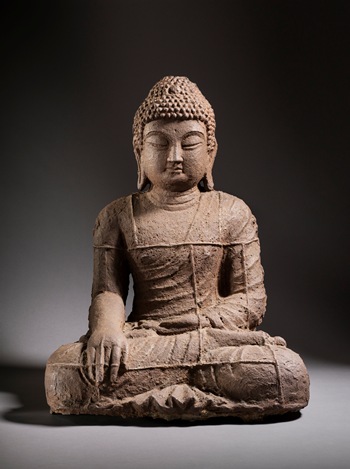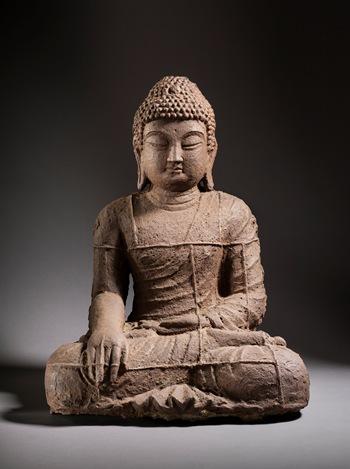On display in the Korean art galleries is one our latest acquisitions, added to the collection at last month’s Collectors Committee event. It is a tenth-century Seated Buddha, made of cast iron and especially notable for its size—it is the largest example of Goryeo Buddhist sculpture outside of Asia.
 Seated Buddha, Korea, Goryeo dynasty, 10th century, gift of the 2013 Collectors Committee
Seated Buddha, Korea, Goryeo dynasty, 10th century, gift of the 2013 Collectors Committee
Buddhism arrived in Korea with the arrival of monks from India and China in the fourth century AD. The foreign religion, which taught a means to transcend life’s inevitable suffering and the cycle of death and rebirth, quickly took hold and was soon supported by members of the royal courts of the Three Kingdoms Period (fourth through seventh centuries). Later, during the Unified Silla (668–935) and Goryeo (918–1392) dynasties, Buddhism enjoyed widespread patronage and flourished throughout the Korean peninsula. Buddhism was transmitted to Japan from Korea in the sixth century.
The Goryeo dynasty, which coincided with the European High Middle Ages, witnessed enthusiastic aristocratic and governmental support for Buddhism. Depicting the historical Buddha Shakyamuni’s Enlightenment at Bodh Gaya, in the modern state of Bihar in India, this magnificent iron sculpture projects a profound sense of meditative calm. Having fended off an attack by the forces of mara (illusion), at the moment of his Enlightenment the Buddha touched the earth with his right hand, thereby calling on the earth to witness his achievement. This sacred gesture is known in Sanskrit as bhumisparsa–mudra, or the “earth-touching gesture.”
Seldom seen in Chinese sculpture before the fifteenth century, and almost never seen in Japanese sculpture, cast iron was widely used in Korea for Buddhist sculpture from the eighth century onward. Examples of Goryeo iron sculpture are rare today—they were easily melted down—and none exist on this scale in any other American collection. This masterpiece of tenth-century Goryeo sculpture is a superb addition to LACMA’s collection of Korean art, particularly as a way to display the great achievements of Goryeo Buddhism to American audiences.
Stephen Little, curator and department head, Chinese and Korean Art



